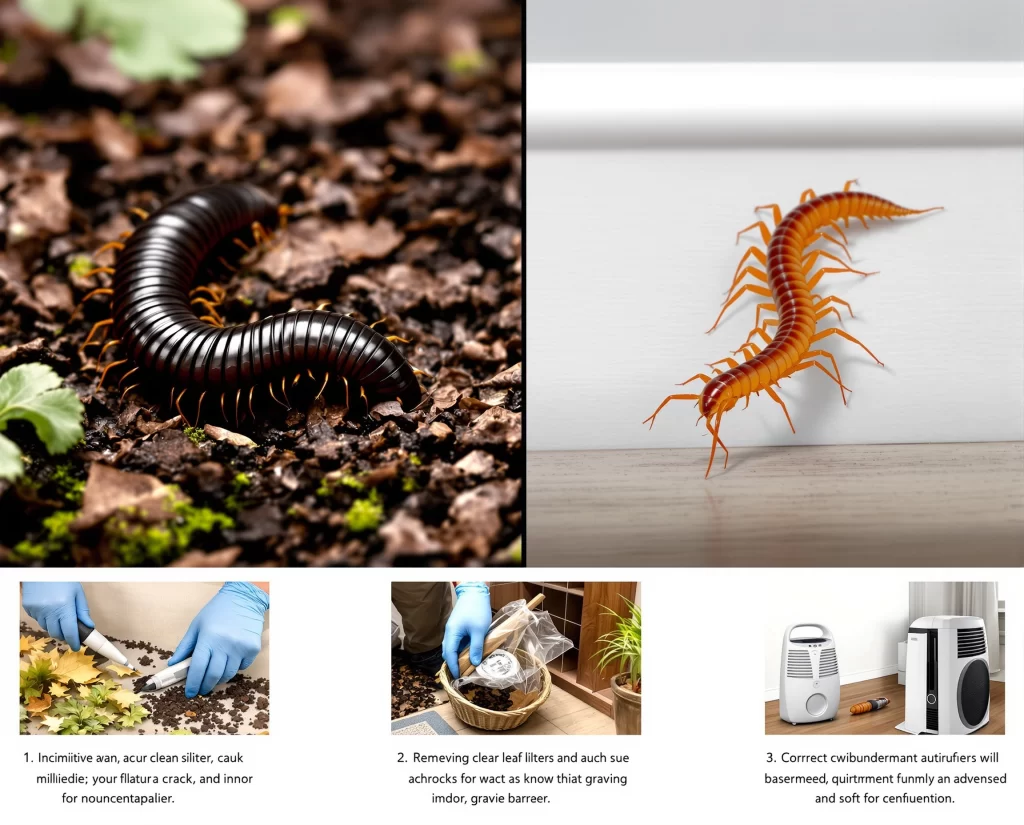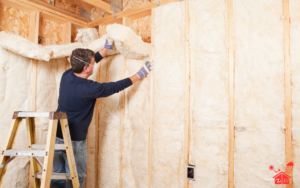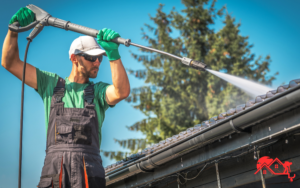Millipedes and centipedes are not the same: millipedes have two pairs of legs per segment, roll up, and eat organic matter; centipedes have one pair of legs per segment, are predators, and can bite. To prevent them, control humidity, seal entrances, and reduce shelters inside and outside your home.
What you’ll learn in this blog
- How to differentiate a millipede from a centipede in seconds.
- Whether centipedes are dangerous and what real risks exist.
- Why they appear in your home or garden.
- Step-by-step prevention that works.
- When to do it yourself and when to call a professional.
The 10-Second Difference: Legs, Body, and Behavior
Quick Summary: Millipedes = two pairs of legs per segment, cylindrical body, slow, roll up, and eat organic matter; Centipedes = one pair of legs per segment, flattened body, fast, predatory, and can bite.
Details that never fail:
- Legs: Millipedes have “many short legs” that point downward; centipedes have longer, lateral legs that look like “wings.”
- Head: Centipedes have long antennae and venomous pincers (forceps) for hunting. Millipedes don’t bite, but some species expel irritating substances.
- Behavior: Millipedes prefer moisture and gather in soil, flowerpots, and leaf litter; centipedes hunt insects, which is why they appear where there are infestations of cockroaches, ants, or flies.
Do you have millipedes or centipedes?
Mini identification guide at home
Imagine you turn on the bathroom light in the middle of the night and something runs under the towel. What is it?
- It runs very fast, like a “comet with legs”: probably a centipede.
- Slow-moving and coiling if touched: millipedes.
- Color and shape: Millipedes are more robust and cylindrical (brown/black); centipedes are flatter, with long, visible legs.
- Risk: Centipedes may bite if trapped (local pain; special care with children, pets, and sensitive individuals). Millipedes don’t bite, but their secretion can irritate the skin. Wash with soap and water if there is contact; if there is a severe reaction, seek medical attention.
Why do they appear?
Moisture, shelter, and food
The inconvenient truth: They don’t arrive “out of nowhere.” They arrive because:
- There is moisture: leaks, condensation, unventilated basements, waterlogged flowerpots.
- They have shelter: cracks, hollow baseboards, firewood stuck to the wall, thick mulch next to the foundation.
- There is food: centipedes follow other pests; Millipedes seek moist organic matter (leaves, humus-rich soil).
Prevention that works (without drama or unnecessary expense)
Think in layers: first, environmental protection, then physical exclusion, and finally, chemical control if necessary.
- Control humidity: repair leaks, use a dehumidifier (45-55% RH), ventilate bathrooms and basements, and water in the morning to allow the soil to dry.
- Remove shelters: move firewood and flower pots 1–2 meters from the house, elevate flower pots with bases, reduce the thickness of mulch to 3–5 cm, and clean leaves stuck to the foundation.
- Seal entrances: use complete screens, weatherstripping on doors, plugs in seldom-used drains, and caulking cracks and wiring.
Step-by-step process (60 minutes, visible results):
1) Check the perimeter: the house’s foundation, doors, windows, vents, and pipes (10 min).
2) Seal and correct: silicone cracks, weatherstripping on the front door, and covering vents with fine mesh (25 min).
3) Reduce humidity: adjust irrigation, turn on exhaust fan/windows, and install a dehumidifier if the hygrometer reads >55% (15 min).
4) Traps and monitoring: place sticky traps on bathroom/kitchen baseboards and record weekly counts (10 min).
Safe control: DIY or professional?
- When to do it yourself: isolated findings, no bites, or infestation. Useful tips: sticky traps, pest-control grade diatomaceous earth on dry baseboards, frequent vacuuming, and thorough sealing. For millipedes in the garden, reducing watering and aerating the soil is usually sufficient.
- When to call a professional: daily appearances, presence in multiple rooms, large centipedes (e.g., Scutigera), or if there are underlying pests (cockroaches, ants). A technician will apply residual perimeter treatments, baits for prey pests (cutting off the centipede’s food), and advanced sealing. Yes, it’s worth it: eliminate the cause, not just the symptom.
Quick Questions People Ask (and Honest Answers)
- Are centipedes dangerous? They can bite, and it hurts, but it’s rarely serious. Sensitive people should monitor for reactions.
- Do millipedes invade due to “rainfall”? Yes, rain drives them to dry places; check ventilation and seals during the season.
- Can I use homemade insecticides? It’s best to prioritize exclusion and humidity. If you use chemicals, read the label and keep children/pets out of the area. Avoid indiscriminate applications.
Conclusion and Next Step
Differentiating between millipedes and centipedes is simple when you know what to look for: leg segments, body shape, and speed. Real prevention starts with controlled humidity, tight sealing, and fewer shelters. If you notice recurring activity, Any Service Near Me can design a comprehensive plan for your home. Let’s talk today and request a quote: solving it now is cheaper than ignoring it.
FAQ
How can I tell if I’m seeing a centipede or a millipede in my home?
Look for three quick cues: centipedes are fast, flatter, and have one long pair of legs per body segment; millipedes are slower, cylindrical, roll up when disturbed, and have two shorter pairs of legs per segment. If you’re unsure, Any Service Near Me can identify the pest during a home inspection and recommend next steps.
Are house centipedes dangerous for kids or pets?
Centipede bites can be painful but are rarely serious; wash with soap and water and monitor for reactions, especially with children, pets, or sensitive individuals. Millipedes don’t bite but can release skin-irritating fluids. For frequent sightings or large centipedes, Any Service Near Me offers safe, targeted treatment that prioritizes prevention and family-friendly control.
Why do centipedes or millipedes show up in my house?
They’re attracted by three things:
- Moisture: leaks, condensation, damp basements, overwatered planters
- Shelter: cracks, gaps, thick mulch against the foundation, firewood stacked against walls
- Food: centipedes follow insects like roaches, ants, and flies; millipedes feed on moist organic matter To address all three, Any Service Near Me focuses on humidity control, exclusion (sealing), and targeted treatments.
What can I do today to get rid of them, and when should I call a pro?
Do this in about 60 minutes:
- Control humidity: run exhaust fans, fix leaks, set a dehumidifier to 45–55% RH, water plants in the morning
- Remove shelters: thin mulch to 1–2 inches, elevate planters, move firewood 3–6 feet from the house, clear leaf litter
- Seal entry points: add door weatherstripping, repair screens, caulk cracks, cover vents with fine mesh, plug seldom-used drains
- Monitor: place sticky traps along bathroom and kitchen baseboards Call a pro if you see pests daily, find them in multiple rooms, notice large centipedes, or suspect underlying insect infestations; Any Service Near Me can pair exclusion with residual treatments and prey-pest control for lasting results.
How long does treatment take, and when will I see results?
Most homes see immediate reductions after sealing and moisture corrections, with measurable declines over 1–2 weeks if residual perimeter treatments are needed; follow-ups typically occur within 2–4 weeks to confirm resolution. For a precise timeline based on your home and activity level, Any Service Near Me provides a customized treatment plan and schedule.
How much do pest control services for centipedes or millipedes cost?
Pricing depends on home size, severity and frequency of sightings, presence of underlying pests (like roaches or ants), the extent of sealing needed, and whether you choose one-time or preventive service. You’ll get the best value from an inspection-based plan that fixes moisture and entry points alongside targeted treatments; Any Service Near Me can provide a clear, no-pressure quote after a quick assessment.





















































